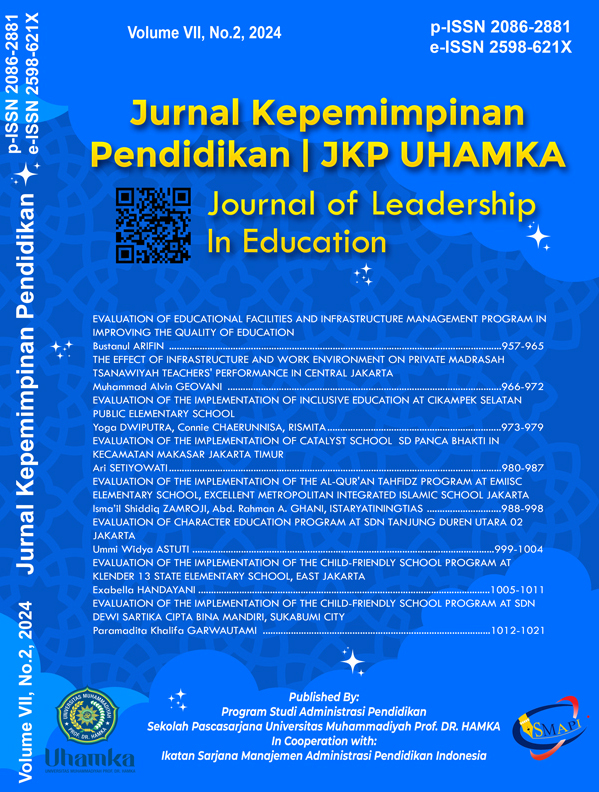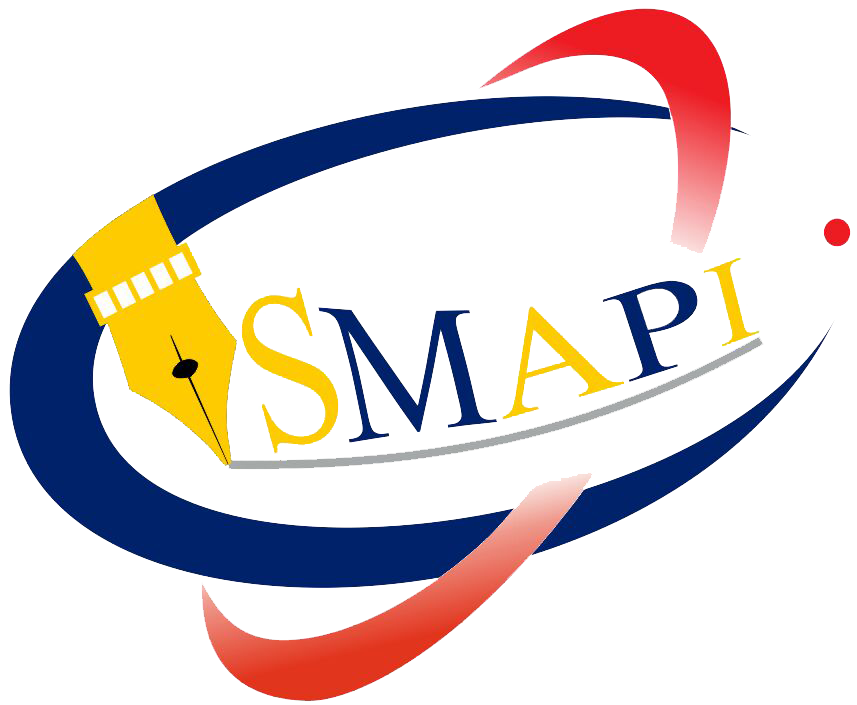EVALUATION OF THE IMPLEMENTATION OF INCLUSIVE EDUCATION AT CIKAMPEK SELATAN PUBLIC ELEMENTARY SCHOOL
DOI:
https://doi.org/10.22236/jkpuhamka.v7i2.18226Keywords:
inclusive education, Evaluation, CIPP Model, elementary schools, ImplementationAbstract
This research aims to evaluate the implementation of inclusive education at SD Negeri Cikampek Selatan 1, Cikampek District, Karawang Regency. A qualitative descriptive approach using the CIPP (Context, Input, Process, Product) evaluation model was employed. Data was collected through interviews, observations, and documentation from teachers, the school principal, and the school committee. The context evaluation shows that the school has the required permission and guidelines for inclusive education, serving children with mild to moderate special needs. The input evaluation reveals inadequate special facilities, modified curriculum, uneven special training, and no special assistant teachers. The process evaluation indicates that teachers' competencies in handling special needs students are good, with individual handling, funding from BOS funds, and no further monitoring from relevant authorities. The product evaluation shows that the academic and non-academic achievements of special needs children are average, with 8 students being served. Based on the findings, the evaluation recommends: 1) Context: Ensure a legal basis, supported by an Inclusive School Implementation Decree; 2) Input: Conduct assessments during student admissions to categorize prospective special needs students; 3) Process: Modify the curriculum to meet the needs of special needs students; 4) Product: Provide additional life skills for special needs students to meet their needs.
Downloads
References
Armstrong, D., Armstrong, A. C., & Spandagou, I. (2011). Inclusion: by choice or by chance? International Journal of Inclusive Education, 15(1), 29–39. https://doi.org/10.1080/13603116.20 10.496192
Bačáková, M., & Cimpairment, A. (2013). Continuing professional development (CPD) as a means to reducing barriers to inclusive education: research study of the education of refugee children in the Czech Republic. European Journal of Special Needs Education, 28(2), 203–216. https://doi.org/10.1080/08856257. 2013.778108
Block, K., Gibbs, L., Macfarlane, S., & Townsend, M. (2015). Promoting appreciation of cultural diversity and inclusion with the Stephanie Alexander Kitchen Garden Program. Journal for Multicultural Education, 9(1), 2–9. https://doi.org/10.1108/ JME-01-2014-0007
Evmenova, A. (2018). Preparing Teachers to Use Universal Design for Learning to Support Diverse Learners. Journal of Online Learning Research, 4(2), 147–171. https://files.eric.ed.gov/ fulltext/EJ1184985.pdf
Forlin, C. (2013). Changing Paradigms and Future Directions for Implementing Inclusive Education in Developing Countries. Asian Journal of Inclusive Education, 2(1), 19–31. https://ajiebd. net/wp-content/uploads/2016/08/chris_forlin_final.pdf
Gül, S. O., & Vuran, S. (2015). Children with Special Needs’ Opinions and Problems about Inclusive Practices. TED EĞİTİM VE BİLİM, 40(180). https://doi.org/10.15390/EB.2015.4205
Idris, F., Hassan, Z., Ya’acob, A., Gill, S. K., & Awal, N. A. M. (2012). T he Role of Education in Shaping Youth’s National Identity. Procedia - Social and Behavioral Sciences, 59, 443–450. https:// doi.org/10.1016/j.sbspro.2012.09.299
Indrawati, Sudarwati, N., & Siyono. (2021). The Role of Education Out of School in Human Resources Development. Indonesian Journal of Education and Learning, 4(2), 486. https://doi. org/10.31002/ijel.v4i2.3868
Kozleski, E. B., Yu, T., Satter, A. L., Francis, G. L., & Haines, S. J. (2015). A Never Ending Journey: Inclusive Education Is a Principle of Practice, Not an End Game. Research and Practice for Persons with Severe Disabilities, 40(3), 211–226. https://doi. org/10.1177/1540796915600717
McLaughlin, T., Aspden, K., & Snyder, P. (2016). Intentional Teaching as a Pathway to Equity in Early Childhood Education: Participation, Quality, and Equity. New Zealand Journal of Educational Studies, 51(2), 175–195. https://doi.org/10.1007/ s40841-016-0062-z
Rofiah, N. H., Sudiraharja, D., & Ediyanto, E. (2020). the Implementation Inclusive Education: Implication for Children With Special Needs in Tamansari Elementary School in Yogyakarta. International Journal of Educational Management and Innovation, 1(1), 82. https://doi.org/10.12928/ijemi.v1i1.1517
Sayed, Y., & Motala, S. (2012). Equity and ‘No Fee’ Schools in South Africa: Challenges and Prospects. Social Policy & Administration, 46(6), 672–687. https://doi.org/10.1111/j.14679515.2012.00862.x
Susilawati, S. Y., bin Mohd Yasin, M. H., & Tahar, M. M. (2023). Influencing factors of inclusive education for students with hearing impairment. Pegem Journal of Education and Instruction, 13(2), 119-125.
Valiandes, S. (2015). Evaluating the impact of differentiated instruction on literacy and reading in mixed ability classrooms: Quality and equity dimensions of education effectiveness. Studies in Educational Evaluation, 45, 17–26. https://doi. org/10.1016/j.stueduc.2015.02.005
Downloads
Published
How to Cite
Issue
Section
License
Copyright (c) 2025 Yoga DWIPUTRA, Connie CHAERUNNISA, Rismita RISMITA

This work is licensed under a Creative Commons Attribution 4.0 International License.















